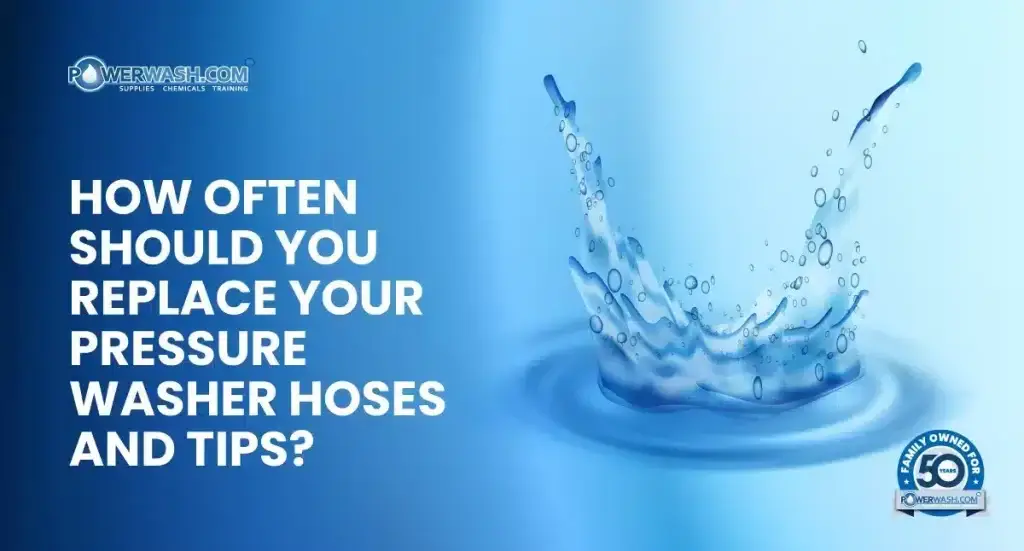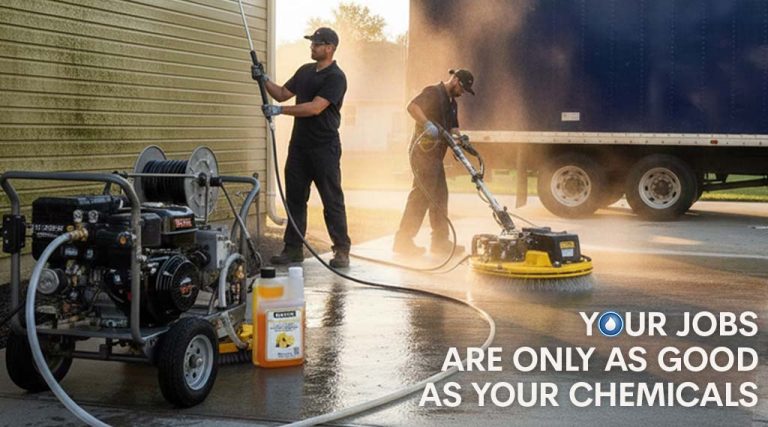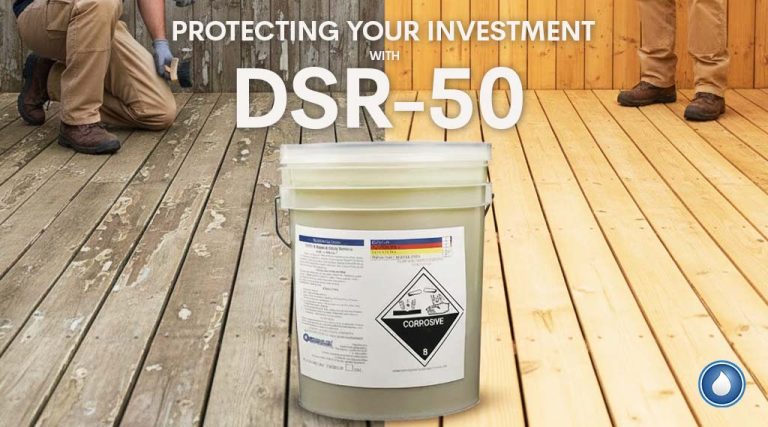- Home
- /
- Power Wash Spray Tips
- /
- How Often Should You Replace Your Pressure Washer Hoses and Tips?
Subscribe To Our Newsletter
Stay in the know on the latest products, deals, events, tips & tricks.
Social Media

How Often Should You Replace Your Pressure Washer Hoses and Tips?
Picture this: you’re outside on a beautiful summer day, ready to tackle your power washing projects with your trusty pressure washer. You turn it on, but instead of a powerful stream of water, your hose bursts and sprays water everywhere. Consider yourself lucky if you didn’t get hurt because the spray from pressure washer hoses can cause serious injury when it bursts open and the water hits your skin. And even damage the home or business owner’s property in the process.
Regularly replacing your pressure washer hoses can reduce exposure to danger and minimize the risk of damaging property. It’s important to keep a close eye on the wear and tear of your hoses and replace them as needed. Experts suggest replacing your pressure washer hoses yearly or sooner if you notice cracks or can see the internal metal braid.
What about the tips on your pressure washer? They may not seem as important as the hoses, but they play a crucial role in the effectiveness of your cleaning. Over time, the tips can become worn or damaged, resulting in a weaker stream of water or uneven pressure. If there is a drop of 10% or more in pressure, it’s likely time for a change. Just like the pressure washer hoses, we recommend replacing your pressure washer tips every year or sooner if you notice any signs of wear and tear. Remember always to keep a spare set of tips on hand and replace them regularly to ensure your pressure washer operates at its best.
Signs Your Pressure Washer Hose Needs Replacing
Pressure washer hoses are made of durable materials designed to withstand high pressure, but they do wear out over time. Some signs your pressure washer hose needs replacing include leaks, cracks, metal braid showing, and kinks.
If you notice a drop in pressure, it could indicate that your hose is clogged or damaged. A clogged hose can cause the pressure washer to overheat and reduce lifespan. Remember to replace hoses as needed and keep some extra on hand.
How Often to Replace Your Pressure Washer Hose
The frequency of replacing your pressure washer hose depends on several factors, such as how often you use it and the type of work you do. Pressure washer hoses last between 300-500 hours of use. If you use your pressure washer frequently for heavy-duty tasks like cleaning concrete or paint removal, you may need to replace it sooner. But if you use your pressure washer occasionally for light-duty tasks like cleaning cars or outdoor furniture, you may only need to replace the hose sometimes.
Signs Your Pressure Washer Tips Need Replacing
Pressure washer tips are responsible for directing the water spray and determining the pressure and angle of the water flow. Over time, the tips can wear out due to factors such as high pressure and debris in the water.
Some signs that your pressure washer tips need replacing include reduced pressure, inconsistent spray pattern, and damage to the tip. If you notice any of these signs, it’s time to replace your tips.
How Often to Replace Your Pressure Washer Tips
The frequency of replacing your pressure washer tips depends on several factors, such as how often you use your pressure washer and the tasks you’re performing. Pressure washer tips should last between 200-500 hours of use.
Just like the pressure washer hoses, if you use your pressure washer frequently or for heavy-duty tasks, you may need to replace the tips more often. But, if you use your pressure washer occasionally or for light-duty tasks, you won’t need to replace the tips as often.
The Importance of Replacing Pressure Washer Hoses and Tips
Replacing your pressure washer hoses and tips is essential for several reasons. It ensures your pressure washer works optimally, providing high-pressure and consistent spray patterns. Replacing your pressure washer hoses and tips helps to prevent leaks and damage to the pressure washer. And a worn-out tip can cause the pressure washer to overwork, leading to overheating and reduced lifespan.
Quick Couplers: What They Are and How They Work
Quick couplers are an essential component of efficient pressure washers. Their purpose is to allow you to snap equipment and accessories together quickly and easily. But how do they work, and what do you need to know to use them effectively? Let’s examine their construction, operation, and common applications.
Anatomy of a Quick Coupler
A quick coupler consists of two main parts: the body and the plug. The body is the part attached to the equipment or accessory, while the plug is attached to the hose or other equipment you want to connect.
The body has a piece that slides back, allowing the release of the ball bearings where the plug goes in. When the body returns to its original position, it locks the ball bearings on the plug so they don’t fall apart. This mechanism ensures a secure connection that won’t come apart during use.
One of the things that can be confusing about quick couplers is that they have two ends that can be identified as male or female. The body piece has a socket to receive the plug. It can be male or female, depending on the pipe thread type on the opposite end, but it will always be a socket. The plug fits into the socket and can be male or female, but it will always be a plug. You must have the right combination of male and female couplers to ensure a proper connection.
Using High-Pressure Quick Couplers for Pressure Washing
One of the most common applications for quick couplers is in pressure washing equipment. High-pressure quick couplers are made of heavy-duty machined brass and are designed to withstand the high pressures generated by pressure washers, ranging from 1000 to 5000 PSI or more.
Quick coupler fittings connect pressure washer hoses, wands, and other accessories quickly and easily, enabling you to switch between tools or nozzles.
When using quick couplers with pressure washers, it’s important to make sure you have the right combination of male and female couplers for your equipment. Most pressure washer hoses have a female quick connect on one end and a male on the other, while wands and other accessories typically have male quick connects. This means you will need a female quick connect on your hose to connect it to the male quick connect on your wand or accessory.
When using quick couplers with pressure washers, they can wear out over time, especially if they are used frequently or exposed to harsh conditions. If you notice that your quick couplers are leaking or not holding a connection properly, it may be time to replace them. The best part is quick couplers are relatively inexpensive and easy to replace!
Key Takeaways:
- Exposure to danger and damaged property can be easily avoided by regularly replacing pressure washer hoses. It’s important to keep a close eye on the wear and tear of your hoses and replace them as needed.
- Over time, the tips can become worn or damaged, resulting in a weaker stream of water or uneven pressure. If there is a drop of 10% or more in pressure, it’s likely time for a change.
- Pressure washer hoses last between 300-500 hours of use.
- Quick couplers are an essential component of efficient pressure washers. Their purpose is to allow you to snap equipment and accessories together quickly and easily.
Keep Your Equipment Efficient With PowerWash.com
Remember to maintain your pressure washer hoses and tips regularly to extend their lifespan and prevent damage to your pressure washer. Using the proper hose and tip for the task ensures optimal performance and prevents surface damage. At PowerWash.com, we’re passionate about helping you access everything you need to run a successful pressure washing business – from tips and hoses to pressure washers; we got you covered! Click the link and get started today!
Related Products
Share This Post
More To Explore
Winter Pressure Washing Maintenance Checklist
Winter Pressure Washing Maintenance Checklist Prepared for Contractors by PowerWash.com. Winter is the most important time of year to protect ...
2025 Tax Changes, New Rigs & Easy Payments: What Power Washing Pros Need to Know Before Dec 31
Updated for the latest federal guidelines. PowerWash.com does not provide tax advice. Always consult your CPA. As the year comes ...
Your Jobs Are Only as Good as Your Chemicals: Here Are the Ones That Stand Out
If your busy season has you running from job to job, you already know this: the equipment you use matters, ...
Stripping Wood the Smart Way (Not the Hard Way)
Deep Wood Restoration Made Simple with DSR-50 Whether you’re a professional deck and fence restoration contractor or a homeowner prepping ...




